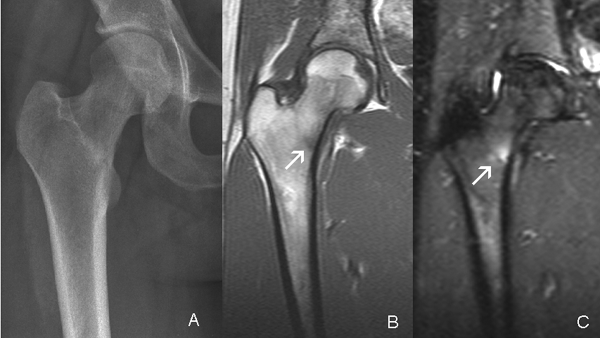What causes Stress Fracture of the Hip?
Stress fracture of the hip is an unusual condition that generally occurs in athletic individuals who begin or significantly increase running/other impact activity. The fracture itself usually occurs in the femoral neck at the base of the ball of the hip joint. Sometimes the fracture can occur in the bone of the pelvis adjacent to the hip and rarely in the femoral head (the ball of the hip joint). A stress fracture begins as a tiny microscopic crack in the bone which slowly increases in size with loading activity such as running. This is different to an acute fracture where there is a single incident or event (ie falling over) that causes the fracture. A stress fracture is like getting a piece of coathanger wire and bending it back and forth – eventually if this cycling continues the wire will break.

Clinical Features
Most individuals with a stress fracture of the hip notice pain in the groin which comes on with running and activity. This pain tends to settle quickly with rest initially and recurs when attempting running again. If running is continued despite the pain then often the condition reaches a point where the pain doesn’t completely settle with rest and in some cases can be present continuously. Stress fractures occur in many bones in the body but the bones of the foot (at the extremity of a weight bearing limb) are most commonly affected.
Investigations for Stress Fracture
Sometimes stress fractures can be seen and diagnosed on plain xrays but frequently scanning (CT or MRI or Nuclear Medicine) is required to be certain.
Figure 1. Stress fracture of the femoral neck. Difficult to see on plain xray but diagnosed on MRI scan.
Treatment of Stress Fracture
Treatment of stress fracture generally requires reversal of the reason the fracture has developed in the first place – too much activity needs to be replaced by REST of the injured limb/joint. Bone generally takes 6-8 weeks to heal and this is the period of time where crutches and non-weight bearing are required. This period can be followed by a period of progressive partial weight bearing (still with crutches) and hopefully crutches can be discarded at approx. 12 weeks. A graduated running program can be started once walking is comfortable with the aim of slowly progressing distance and possibly speed over a period of 3 months. If pain recurs at any stage in this process then activity is reduced again until the pain settles. Occasionally stress fractures of the femoral neck require surgery – these types of fracture have a particular pattern on CT/MRI scan.
Figure 2. A stress fracture of the femoral neck traversing almost completely across the width of the bone. This type of fracture usually requires surgical fixation.
A variation on the typical stress fracture of the hip is the kind of fracture seen in the upper femur which can occur secondary to osteomalacia (VitaminD deficiency), parathyroid disease and with the use of bisphosphonate drugs for the treatment of osteoporosis.
Figure 3. An unusual fracture of the upper femur thought to be secondary to bisphosphonate medication.
Source: https://www.parkclinic.com.au/stress-fracture-hip-femoral-neck/



